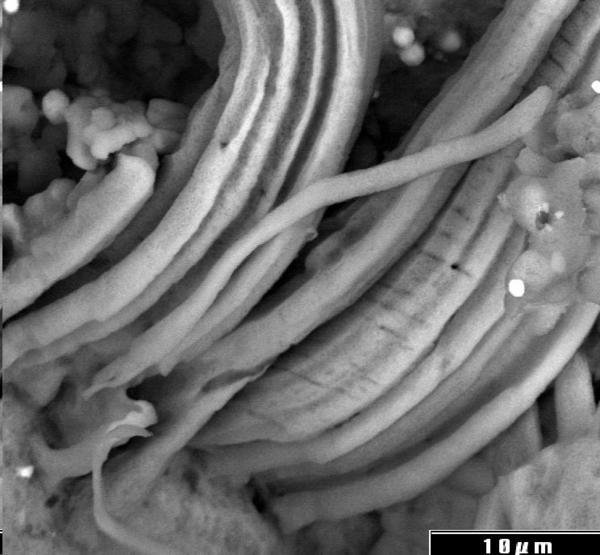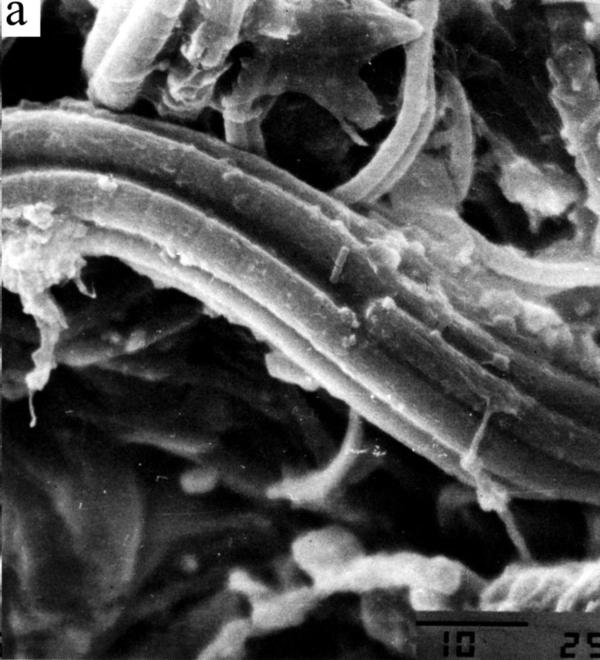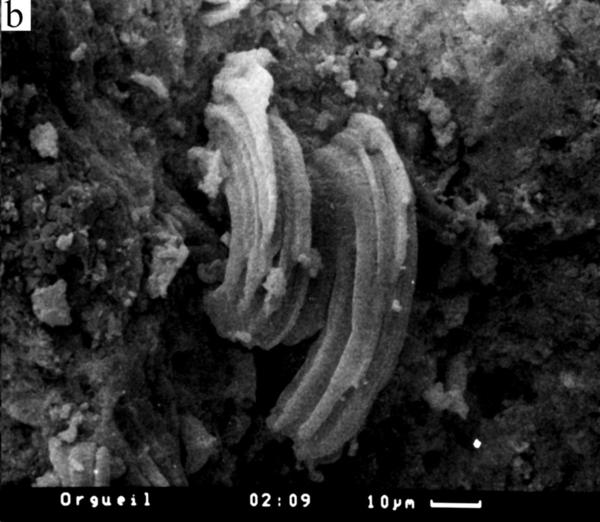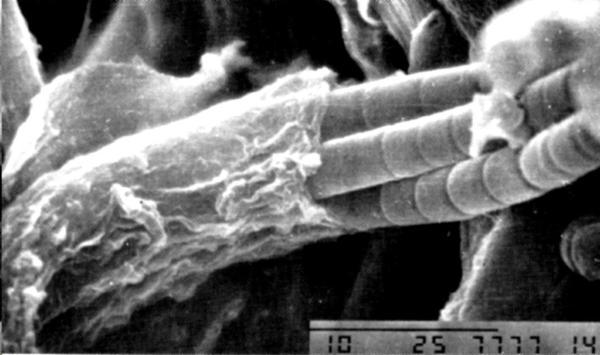|
Richard B. Hoover of NASA/NSSTC announced today, 02 August 2004, the discovery of evidence for the detection of a fossilized cyanobacterial mat in a freshly fractured, interior surface of the Orgueil carbonaceous meteorite. Many of the images presented were obtained 21-23 July 2004, using the Field Emission Scanning Electron Microscope at NASA's Marshall Space Flight Center in Huntsville, Alabama. The announcement was made in Denver, Colorado at the "Instruments, Methods, and Missions for Astrobiology VIII" (Conference 5555) at SPIE's International Symposium on Optical Science and Technology (its 49th Annual Meeting).
 Hoover presented numerous high resolution Field Emission Scanning Electron Microscope (FESEM) images and EDAX Spectral Analysis of the chemical composition of these large, extremely complex, and beautifully preserved indigenous microfossils and microbial assemblages. He also presented images of living and fossil cyanobacteria and sulfur bacteria and data on exotic mineral microstructures that he had also found in the carbonaceous meteorites. Many of these microfossils shown were clearly recognizable as the mineralized or carbonized remains of cyanobacteria. The cyanobacteria are well known and long-studied oxygenic phototrophic prokaryotes. Since they obtain their energy by photosynthesis, they do not infiltrate the interiors of opaque, black rocks, such as carbonaceous meteorites. Some Antarctic forms are cryptoendolithic and grow during the continuous sunlight of the polar summer, appearing as bright green bands near the surface of moist translucent rocks. Many of the fossilized cyanobacteria (and filamentous sulfur bacteria) are very large — 1 to 10 microns in diameter and with filament lengths sometimes in excess of 150 microns. Although many of the forms discovered in the meteorite have not yet been identified, several have. Many of the forms have the correct size of trichomes and sheaths, and exhibit complex morphology, branching, and other features, such as the presence of germlings, heterocysts, apical cells, akinetes, and hormogonia that permit them to be recognized and their taxonomy established in accordance with the characteristics set forth in Bergey's Manual of Systematic Bacteriology, Vol. 1 (1). Genera and species of ecologically consistent communities of filamentous sheathed cyanobacteria (e.g. Microcoleus spp., Nostoc, spp., Phormidium spp., Mastigocladus spp., etc.) have been found in association with sulfur bacteria and haloalkaliphiles. Hoover presented numerous high resolution Field Emission Scanning Electron Microscope (FESEM) images and EDAX Spectral Analysis of the chemical composition of these large, extremely complex, and beautifully preserved indigenous microfossils and microbial assemblages. He also presented images of living and fossil cyanobacteria and sulfur bacteria and data on exotic mineral microstructures that he had also found in the carbonaceous meteorites. Many of these microfossils shown were clearly recognizable as the mineralized or carbonized remains of cyanobacteria. The cyanobacteria are well known and long-studied oxygenic phototrophic prokaryotes. Since they obtain their energy by photosynthesis, they do not infiltrate the interiors of opaque, black rocks, such as carbonaceous meteorites. Some Antarctic forms are cryptoendolithic and grow during the continuous sunlight of the polar summer, appearing as bright green bands near the surface of moist translucent rocks. Many of the fossilized cyanobacteria (and filamentous sulfur bacteria) are very large — 1 to 10 microns in diameter and with filament lengths sometimes in excess of 150 microns. Although many of the forms discovered in the meteorite have not yet been identified, several have. Many of the forms have the correct size of trichomes and sheaths, and exhibit complex morphology, branching, and other features, such as the presence of germlings, heterocysts, apical cells, akinetes, and hormogonia that permit them to be recognized and their taxonomy established in accordance with the characteristics set forth in Bergey's Manual of Systematic Bacteriology, Vol. 1 (1). Genera and species of ecologically consistent communities of filamentous sheathed cyanobacteria (e.g. Microcoleus spp., Nostoc, spp., Phormidium spp., Mastigocladus spp., etc.) have been found in association with sulfur bacteria and haloalkaliphiles.
 Hoover Hoover | |
Hoover presented several dramatic images and the associated EDAX spectral data of living and fossil cyanobacteria haloalkaliphilic mats, the Cambrian phosphorites of Khubsughul, Mongolia for comparison with the recent discoveries in the Orgueil and Murchison carbonaceous meteorites. Evidence for possible microfossils in meteorites was previously reported in numerous papers by many scientists (Nagy, Claus, Timofeyev, Van Landingham, Palik, McKay, Rozanov, Hoover, etc.) These results have previously been attacked by critics, who have argued to dismiss them on the basis that they were too small to represent living organisms or that they must be mineral grains, artifacts produced by coating the sample, or recent pollen or fungal contaminants that were introduced during acid maceration, cleaning, or while the specimen was lying in some museum drawer. Hoover detailed his extensive sample handling and contamination prevention protocols and described the chemical and microbiological rational why these lithified and carbonized remains could not be logically dismissed as recent contaminants. He also discussed the the microbiology, bioenergetics and life habits of phototrophic and chemilithotrophic bacteria, the chemical compositions and mode of preseveration of the microbial remains, and the ecological, environmental, reproductive, and community association aspects of the microbial communities of cyanobacterial mats such as those found in the meteorites that indicate the forms discovered can not be logically dismissed as either mineral grains or post-arrival microbial contaminants. The recently discovered microfossils are not isolated single cells, but represent mats of cyanobacteria and sulfur bacterial and ecologically consistent communities and assemblages. Hoover concludes that these communities grew on the meteorite's parent body before it entered the atmosphere of Earth.
Hoover has described these details and provided High Resolution FESEM Images and X-Ray Spectral Data in a paper that will appear in the Proceedings of the SPIE Conference 5555 (3). Additional images and elemental data are now being obtained to be included in other papers that are now being prepared for submission to scientific journals. (See, for example, "Fossils of Cyanobacteria...", linked below.)
| Microfossils in Orgueil; photo by Richard B. Hoover, NASA/NSSTC, 21-23 July 2004; sample courtesy of Paul Sipiera, the Dupont Meteorite Collection of the Planetary Studies Foundation. |
|
| Living cyanobacteria Microcoleus chthonoplastes with trichome bundles in a common sheath, for comparison to microfossils from Orgueil; photo by Ludmilla Gerasimenko, Institute of Microbiology, Russian Academy of Sciences (2). | |
| Microfossils in Orgueil; photo by Alexei Rozanov, Paleontology Institute, Russian Academy of Sciences; sample courtesy of E. Galimov, Vernadsky Institute, RAS. |
|
| Living cyanobacteria Microcoleus chthonoplastes emerge from wrinkled muscilaginous sheath, showing individual cells in filament, for comparison to microfossils from Orgueil; photo by Ludmilla Gerasimenko, Institute of Microbiology, Russian Academy of Sciences (2). |
|
References
1. George M. Garrity, Editor-in-Chief, Bergey's Manual of Systematic Bacteriology, 2nd Ed., Vol. 1, The Archaea and Deeply Branching and Phototrophic Bacteria, New York, Springer-Verlag, 2001.
2. Elena A. Zhegallo, Alexei Yu. Rozanov, Galina T. Ushatinskaya, Richard B. Hoover, Ludmila M. Gerasimenko and Alla L. Ragozina, Atlas of Microorganisms from Ancient Phosphorites of Khubsughul (Mongolia), NASA/TP 209901 (In English and Russian), pp. 1-167, 61 Figs. (2000).
3. Richard B. Hoover, Gregory Jerman, Alexei Y. Rozanov and Paul P. Sipiera, "Indigenous microfossils in carbonaceous meteorites" [abstract], p 1-17, Proceedings of SPIE Volume 5555: Instruments, Methods, and Missions for Astrobiology VIII, [contents], Richard B. Hoover, Gilbert V. Levin and Alexei Y. Rozanov; eds., ISBN 0-8194-5493-1, Nov 2004.
Richard Hoover: collected articles and videos
 Fossils Found in Meteorites Since 1961, a 5-hour interview with Richard B. Hoover by Brian C Dobbs on YouTube, publicised 20 Oct 2024. Fossils Found in Meteorites Since 1961, a 5-hour interview with Richard B. Hoover by Brian C Dobbs on YouTube, publicised 20 Oct 2024.
 Astrobiology: Biomolecules and Life on Earth and in Icy Moons, Comets and Asteroids, a 100-minute illustrated lecture by Richard B. Hoover for Eco Astronomy, Sri Lanka, 18 Aug 2024. Astrobiology: Biomolecules and Life on Earth and in Icy Moons, Comets and Asteroids, a 100-minute illustrated lecture by Richard B. Hoover for Eco Astronomy, Sri Lanka, 18 Aug 2024.
 Richard Hoover, a biography with links posted on Blue Planet Red, 2024. Richard Hoover, a biography with links posted on Blue Planet Red, 2024.
 Seeking extremophiles with Richard Hoover, 3-min video, 2024. Seeking extremophiles with Richard Hoover, 3-min video, 2024.
 "Origin of Earth's Biosphere," 86 min. lecture by Richard B. Hoover, Colloquium of the Astronomical Observatory, Belgrade, Serbia, 23 Sep 2022. "Origin of Earth's Biosphere," 86 min. lecture by Richard B. Hoover, Colloquium of the Astronomical Observatory, Belgrade, Serbia, 23 Sep 2022.
 "Meteorites comets, rogue planets and the distribution of biosphere" [local abstract | 25-min video >:46] by Richard B. Hoover, World Conference on Basic Sciences and Sustainable Development, Belgrade, Serbia, 19-22 Sep 2022. "Meteorites comets, rogue planets and the distribution of biosphere" [local abstract | 25-min video >:46] by Richard B. Hoover, World Conference on Basic Sciences and Sustainable Development, Belgrade, Serbia, 19-22 Sep 2022.
 Significance to Astrobiology of Micro-organisms in Permafrost and Ice by Richard B. Hoover and David Gilchinsky, presented at the Russian Academy of Sciences, Jun 2022. Significance to Astrobiology of Micro-organisms in Permafrost and Ice by Richard B. Hoover and David Gilchinsky, presented at the Russian Academy of Sciences, Jun 2022.
 "ENAA and SEM investigations of Carbonaceous Meteorites: Implications to the
distribution of life and biospheres" [local pdf], by Hoover RB, Frontasyeva M, Pavlov S, Rozanov AYU, Wallis
DH, Wickramasinghe NC, Acad. J. Sci. Res. 9(5):
096-104, 2021. "ENAA and SEM investigations of Carbonaceous Meteorites: Implications to the
distribution of life and biospheres" [local pdf], by Hoover RB, Frontasyeva M, Pavlov S, Rozanov AYU, Wallis
DH, Wickramasinghe NC, Acad. J. Sci. Res. 9(5):
096-104, 2021.
 New Findings of Microfossils in the Orgueil Meteorite by A. Yu. Rozanov, R. B. Hoover et al., doi:10.1134/S0031030121010111, Paleontological Journal, 2021. New Findings of Microfossils in the Orgueil Meteorite by A. Yu. Rozanov, R. B. Hoover et al., doi:10.1134/S0031030121010111, Paleontological Journal, 2021.
 Diatoms in Carbonaceous Meteorites by Richard Hoover and Alexei Rozanov, 14-min video, 2021. Diatoms in Carbonaceous Meteorites by Richard Hoover and Alexei Rozanov, 14-min video, 2021.
 "Epithermal Neutron Activation Analysis of Carbonaceous Chondrites and the Polonnaruwa/Aralaganwila Stones," by RB Hoover, M Frontasyeva and S Pavlov [local pdf], Aspects Min Miner Sci., 15 Dec 2020. "Epithermal Neutron Activation Analysis of Carbonaceous Chondrites and the Polonnaruwa/Aralaganwila Stones," by RB Hoover, M Frontasyeva and S Pavlov [local pdf], Aspects Min Miner Sci., 15 Dec 2020.
 The Orgueil meteorite (Atlas of microfossils) by Alexei Yu. Rozanov, Richard B. Hoover et al., Joint Institute for Nuclear Research, Russia, Oct 2020. [local pdf] The Orgueil meteorite (Atlas of microfossils) by Alexei Yu. Rozanov, Richard B. Hoover et al., Joint Institute for Nuclear Research, Russia, Oct 2020. [local pdf]
 Diatoms in the Orgueil Meteorite [local pdf], by R. B. Hoover et al., doi:10.1134/S0031030118130051, pp1647–1650, n13, v52, Paleontological Journal, 2018. Diatoms in the Orgueil Meteorite [local pdf], by R. B. Hoover et al., doi:10.1134/S0031030118130051, pp1647–1650, n13, v52, Paleontological Journal, 2018.
 Meteorite Contamination and "The Dog that Didn't Bark" [docx | pdf], 13 Jun 2016. Meteorite Contamination and "The Dog that Didn't Bark" [docx | pdf], 13 Jun 2016.
 Instruments and Methods to Search for Extraterrestrial Life by Richard B. Hoover, SPIE Proceedings Vol. 9606: Instruments, Methods, and Missions for Astrobiology XVII, 9-11 Aug 2015. Instruments and Methods to Search for Extraterrestrial Life by Richard B. Hoover, SPIE Proceedings Vol. 9606: Instruments, Methods, and Missions for Astrobiology XVII, 9-11 Aug 2015.
 "Ocean in Enceladus Enhances the Case for Panspermia" [abstract], by Chandra Wickramasinghe, Richard Hoover et al., SPIE Proceedings Vol. 9606, 25 Sep 2015. "Ocean in Enceladus Enhances the Case for Panspermia" [abstract], by Chandra Wickramasinghe, Richard Hoover et al., SPIE Proceedings Vol. 9606, 25 Sep 2015.
 Evidence of ancient microbial activity on Mars by Jamie Wallis, Richard Hoover et al., SPIE Proceedings Vol. 9606: Instruments, Methods, and Missions for Astrobiology XVII, 9-11 Aug 2015. Evidence of ancient microbial activity on Mars by Jamie Wallis, Richard Hoover et al., SPIE Proceedings Vol. 9606: Instruments, Methods, and Missions for Astrobiology XVII, 9-11 Aug 2015.
 Richard Hoover interviewed by Lee Speigel on Open Minds, 23.5 min YouTube video, 19 Feb 2014. Richard Hoover interviewed by Lee Speigel on Open Minds, 23.5 min YouTube video, 19 Feb 2014.
 Vera M. Kolb and Richard Hoover, "Perchlorates are compatible with life on Earth – Why not Mars?" [local PDF], SPIE Proceedings Vol. 8865, Instruments, Methods, and Missions for Astrobiology XV, Aug 2013. Vera M. Kolb and Richard Hoover, "Perchlorates are compatible with life on Earth – Why not Mars?" [local PDF], SPIE Proceedings Vol. 8865, Instruments, Methods, and Missions for Astrobiology XV, Aug 2013.
 Richard B. Hoover, "Fossils of Cyanobacteria in CI1 Carbonaceous Meteorites: Implications to Life on Comets, Europa, and Enceladus" [ResearchGate | local PDF], Journal of Cosmology, online 3 Mar 2011. Richard B. Hoover, "Fossils of Cyanobacteria in CI1 Carbonaceous Meteorites: Implications to Life on Comets, Europa, and Enceladus" [ResearchGate | local PDF], Journal of Cosmology, online 3 Mar 2011.
 "Dear Kasper" – email from Richard Hoover to a seventh-grade science class [local doc], c. 20 Nov 2011. "Dear Kasper" – email from Richard Hoover to a seventh-grade science class [local doc], c. 20 Nov 2011.
 Richard Hoover, "Chiral amino acids in meteorites strengthen evidence for extraterrestrial life," SPIE, 15 Sep 2010. Richard Hoover, "Chiral amino acids in meteorites strengthen evidence for extraterrestrial life," SPIE, 15 Sep 2010.
 More Evidence for Indigenous Microfossils in Carbonaceous Meteorites [local link], by Richard Hoover and Brig Klyce, 15 Aug 2010. More Evidence for Indigenous Microfossils in Carbonaceous Meteorites [local link], by Richard Hoover and Brig Klyce, 15 Aug 2010.
 Astrobiologist Richard Hoover discusses his work in a 5-min. video, "Extremophile Hunter," produced for the National Science Foundation's online magazine Science Nation, 1 Jun 2009. Astrobiologist Richard Hoover discusses his work in a 5-min. video, "Extremophile Hunter," produced for the National Science Foundation's online magazine Science Nation, 1 Jun 2009.
 Richard B. Hoover and Vera Kolb, "On the search for the amino acids on the lunar surface as it relates to other extraterrestrial bodies," [PDF], 2009. Richard B. Hoover and Vera Kolb, "On the search for the amino acids on the lunar surface as it relates to other extraterrestrial bodies," [PDF], 2009.
 R. B. Hoover, "Schirmacher Oasis/Lake Untersee AntarcticaAstrobiology Expedition" [local pdf], 29 May 2008. R. B. Hoover, "Schirmacher Oasis/Lake Untersee AntarcticaAstrobiology Expedition" [local pdf], 29 May 2008.
 R. B. Hoover, "Comets, carbonaceous meteorites, and the origin of the biosphere" [abstract | pdf], p 23-70 v 3, Biogeosciences Discussions, G.A. Zazarin, A.Y. Rozanov, N.A. Kolchanov, and F. Westall, eds., Jan 2006. R. B. Hoover, "Comets, carbonaceous meteorites, and the origin of the biosphere" [abstract | pdf], p 23-70 v 3, Biogeosciences Discussions, G.A. Zazarin, A.Y. Rozanov, N.A. Kolchanov, and F. Westall, eds., Jan 2006.
 Richard B. Hoover, "Mineralized Remains of Morphotypes of Filamentous Cyanobacteria in Carbonaceous Meteorites" [abstract], doi:10.1117/12.624419, p 166-182, Proceedings of SPIE Volume 5906: Astrobiology and Planetary Missions, Sep 2005. Richard B. Hoover, "Mineralized Remains of Morphotypes of Filamentous Cyanobacteria in Carbonaceous Meteorites" [abstract], doi:10.1117/12.624419, p 166-182, Proceedings of SPIE Volume 5906: Astrobiology and Planetary Missions, Sep 2005.
 The search for alien life on Earth by Paul Davies, The Sydney Morning Herald, 1 Aug 2005. The search for alien life on Earth by Paul Davies, The Sydney Morning Herald, 1 Aug 2005.
 NASA Astrobiologist Identifies New 'Extreme' Life Form, by Steve Roy, Marshall Space Flight Center, 23 Feb 2005 [local link with discussion]. NASA Astrobiologist Identifies New 'Extreme' Life Form, by Steve Roy, Marshall Space Flight Center, 23 Feb 2005 [local link with discussion].
 Richard B. Hoover et al., "Astrobiology of Comets" [abstract | local pdf], doi:10.1117/12.566496, Proceedings of SPIE 5555: Instruments, Methods, and Missions for Astrobiology VIII, 1 Nov 2004. Richard B. Hoover et al., "Astrobiology of Comets" [abstract | local pdf], doi:10.1117/12.566496, Proceedings of SPIE 5555: Instruments, Methods, and Missions for Astrobiology VIII, 1 Nov 2004.
 Richard B. Hoover et al., "Biomarkers and Microfossils in the Murchison, Rainbow, and Tagish Lake meteorites" [abstract], p 15-31, SPIE Proceedings Vol. 4859: Instruments, Methods, and Missions for Astrobiology V, 26 Feb 2003. Richard B. Hoover et al., "Biomarkers and Microfossils in the Murchison, Rainbow, and Tagish Lake meteorites" [abstract], p 15-31, SPIE Proceedings Vol. 4859: Instruments, Methods, and Missions for Astrobiology V, 26 Feb 2003.
 A. Yu. Rozanov and R. B. Hoover, "Biomorphs in Carbonaceous Chondrites" [PDF: abstract], 32nd Lunar and Planetary Science Conference, Houston TX, 12-16 March 2001. A. Yu. Rozanov and R. B. Hoover, "Biomorphs in Carbonaceous Chondrites" [PDF: abstract], 32nd Lunar and Planetary Science Conference, Houston TX, 12-16 March 2001.
 Hakeem M. Olusey... Richard B. Hoover et al., "Observation and Modelling of the Solar Transition Region. I. Multi-Spectral Solar Telescope Array Observatins" [local PDF], The Astrophysical Journal, 20 Oct 1999. Hakeem M. Olusey... Richard B. Hoover et al., "Observation and Modelling of the Solar Transition Region. I. Multi-Spectral Solar Telescope Array Observatins" [local PDF], The Astrophysical Journal, 20 Oct 1999.
 Richard Hoover, Alexei Yu. Rozanov, S. I. Zhmur and V. M. Gorlenko, "Further Evidence of Microfossils in Carbonaceous Chondrites," Proceedings of SPIE Vol. 3441: Instruments, Methods, and Missions for Astrobiology, 1998. Richard Hoover, Alexei Yu. Rozanov, S. I. Zhmur and V. M. Gorlenko, "Further Evidence of Microfossils in Carbonaceous Chondrites," Proceedings of SPIE Vol. 3441: Instruments, Methods, and Missions for Astrobiology, 1998.
 Richard B. Hoover, Fred Hoyle, Chandra Wickramasinghe, Miriam J. Hoover and S. Al-Mufti, "Diatoms on Earth, Comets, Europa, and in Interstellar Space," [PDF: 5Mb], p 19-45 v 35, Earth Moon and Planets, D. Reidel Publishing Company, 1986. Richard B. Hoover, Fred Hoyle, Chandra Wickramasinghe, Miriam J. Hoover and S. Al-Mufti, "Diatoms on Earth, Comets, Europa, and in Interstellar Space," [PDF: 5Mb], p 19-45 v 35, Earth Moon and Planets, D. Reidel Publishing Company, 1986.
 R. Hoover, F. Hoyle, M.K. Wallis and N.C. Wickramasinghe, "Diatoms in Comets," [local pdf], Asteroids, comets, meteors II; Proceedings of the International Meeting, Uppsala, Sweden, June 3-6, 1985, Astronomiska Observatoriet, 1986, p. 359-362. R. Hoover, F. Hoyle, M.K. Wallis and N.C. Wickramasinghe, "Diatoms in Comets," [local pdf], Asteroids, comets, meteors II; Proceedings of the International Meeting, Uppsala, Sweden, June 3-6, 1985, Astronomiska Observatoriet, 1986, p. 359-362.
 Richard B. Hoover, "Those Marvelous, Myriad Diatoms," [PDF: 2Mb], p 870-878, National Geographic, June 1979. Richard B. Hoover, "Those Marvelous, Myriad Diatoms," [PDF: 2Mb], p 870-878, National Geographic, June 1979.
 Richard B. Hoover, "Diffraction Plates for Classroom Demonstrations," [abstract], Am. J. Phys., 1969. Richard B. Hoover, "Diffraction Plates for Classroom Demonstrations," [abstract], Am. J. Phys., 1969.
Historical References
 Vera M. Kolb, "Oxidation of organic materials with perchlorates: Relevance to the chemistry on the Martian surface" [local PDF], SPIE Proceedings Vol. 7441, Instruments, Methods, and Missions for Astrobiology XII, Aug 2009. Vera M. Kolb, "Oxidation of organic materials with perchlorates: Relevance to the chemistry on the Martian surface" [local PDF], SPIE Proceedings Vol. 7441, Instruments, Methods, and Missions for Astrobiology XII, Aug 2009.
 George Claus and Bartholomew Nagy, "A Microbial Examination of Some Carbonaceous Chondrites," [PDF], Nature, 18 November 1961. George Claus and Bartholomew Nagy, "A Microbial Examination of Some Carbonaceous Chondrites," [PDF], Nature, 18 November 1961.
 George Claus, "Contributions to the Knowledge of the Blue-Green Algae...," [PDF: 3Mb], Int. Rev. ges. Hydrobiol., 1961. George Claus, "Contributions to the Knowledge of the Blue-Green Algae...," [PDF: 3Mb], Int. Rev. ges. Hydrobiol., 1961.
 William T. Hall and George Claus, "Ultrastructural Studies of Blue-Green Algal Symbiont," [PDF: 1.4Mb | local PDF], The Journal of Cell Biology, 1963. William T. Hall and George Claus, "Ultrastructural Studies of Blue-Green Algal Symbiont," [PDF: 1.4Mb | local PDF], The Journal of Cell Biology, 1963.
 Carl Sagan, "Indigenous Organic Matter on the Moon," [PDF], 15 Apr 1960. Carl Sagan, "Indigenous Organic Matter on the Moon," [PDF], 15 Apr 1960.
 R.R. Stroecker, "Survival of Blue-Green Algae under Primitive Atmospheric Conditions," [PDF: 2Mb], Dec 1970. R.R. Stroecker, "Survival of Blue-Green Algae under Primitive Atmospheric Conditions," [PDF: 2Mb], Dec 1970.
|





![]() Vera M. Kolb, "Oxidation of organic materials with perchlorates: Relevance to the chemistry on the Martian surface" [local PDF], SPIE Proceedings Vol. 7441, Instruments, Methods, and Missions for Astrobiology XII, Aug 2009.
Vera M. Kolb, "Oxidation of organic materials with perchlorates: Relevance to the chemistry on the Martian surface" [local PDF], SPIE Proceedings Vol. 7441, Instruments, Methods, and Missions for Astrobiology XII, Aug 2009.
![]() George Claus and Bartholomew Nagy, "A Microbial Examination of Some Carbonaceous Chondrites," [PDF], Nature, 18 November 1961.
George Claus and Bartholomew Nagy, "A Microbial Examination of Some Carbonaceous Chondrites," [PDF], Nature, 18 November 1961.
![]() George Claus, "Contributions to the Knowledge of the Blue-Green Algae...," [PDF: 3Mb], Int. Rev. ges. Hydrobiol., 1961.
George Claus, "Contributions to the Knowledge of the Blue-Green Algae...," [PDF: 3Mb], Int. Rev. ges. Hydrobiol., 1961.
![]() William T. Hall and George Claus, "Ultrastructural Studies of Blue-Green Algal Symbiont," [PDF: 1.4Mb | local PDF], The Journal of Cell Biology, 1963.
William T. Hall and George Claus, "Ultrastructural Studies of Blue-Green Algal Symbiont," [PDF: 1.4Mb | local PDF], The Journal of Cell Biology, 1963.
![]() Carl Sagan, "Indigenous Organic Matter on the Moon," [PDF], 15 Apr 1960.
Carl Sagan, "Indigenous Organic Matter on the Moon," [PDF], 15 Apr 1960.
![]() R.R. Stroecker, "Survival of Blue-Green Algae under Primitive Atmospheric Conditions," [PDF: 2Mb], Dec 1970.
R.R. Stroecker, "Survival of Blue-Green Algae under Primitive Atmospheric Conditions," [PDF: 2Mb], Dec 1970.
 Hoover presented numerous high resolution Field Emission Scanning Electron Microscope (FESEM) images and EDAX Spectral Analysis of the chemical composition of these large, extremely complex, and beautifully preserved indigenous microfossils and microbial assemblages. He also presented images of living and fossil cyanobacteria and sulfur bacteria and data on exotic mineral microstructures that he had also found in the carbonaceous meteorites. Many of these microfossils shown were clearly recognizable as the mineralized or carbonized remains of cyanobacteria. The cyanobacteria are well known and long-studied oxygenic phototrophic prokaryotes. Since they obtain their energy by photosynthesis, they do not infiltrate the interiors of opaque, black rocks, such as carbonaceous meteorites. Some Antarctic forms are cryptoendolithic and grow during the continuous sunlight of the polar summer, appearing as bright green bands near the surface of moist translucent rocks. Many of the fossilized cyanobacteria (and filamentous sulfur bacteria) are very large — 1 to 10 microns in diameter and with filament lengths sometimes in excess of 150 microns. Although many of the forms discovered in the meteorite have not yet been identified, several have. Many of the forms have the correct size of trichomes and sheaths, and exhibit complex morphology, branching, and other features, such as the presence of germlings, heterocysts, apical cells, akinetes, and hormogonia that permit them to be recognized and their taxonomy established in accordance with the characteristics set forth in Bergey's Manual of Systematic Bacteriology, Vol. 1
Hoover presented numerous high resolution Field Emission Scanning Electron Microscope (FESEM) images and EDAX Spectral Analysis of the chemical composition of these large, extremely complex, and beautifully preserved indigenous microfossils and microbial assemblages. He also presented images of living and fossil cyanobacteria and sulfur bacteria and data on exotic mineral microstructures that he had also found in the carbonaceous meteorites. Many of these microfossils shown were clearly recognizable as the mineralized or carbonized remains of cyanobacteria. The cyanobacteria are well known and long-studied oxygenic phototrophic prokaryotes. Since they obtain their energy by photosynthesis, they do not infiltrate the interiors of opaque, black rocks, such as carbonaceous meteorites. Some Antarctic forms are cryptoendolithic and grow during the continuous sunlight of the polar summer, appearing as bright green bands near the surface of moist translucent rocks. Many of the fossilized cyanobacteria (and filamentous sulfur bacteria) are very large — 1 to 10 microns in diameter and with filament lengths sometimes in excess of 150 microns. Although many of the forms discovered in the meteorite have not yet been identified, several have. Many of the forms have the correct size of trichomes and sheaths, and exhibit complex morphology, branching, and other features, such as the presence of germlings, heterocysts, apical cells, akinetes, and hormogonia that permit them to be recognized and their taxonomy established in accordance with the characteristics set forth in Bergey's Manual of Systematic Bacteriology, Vol. 1